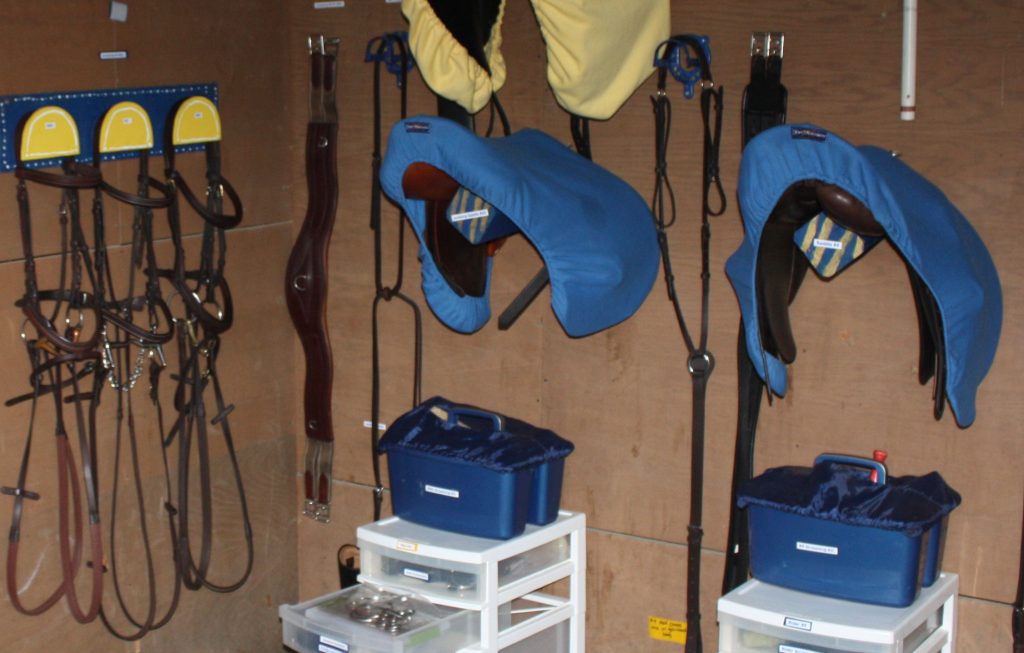Horsemanship Level 3: Saddlery
As a Level 2 Horseman you were asked to be able to tack up independently with properly adjusted tack. For the most part this entails doing up the girth and throatlatch to the holes that show the most wear on your horse's saddle. If everything else is straight and in the right place, with runners and keepers done up you will pass. For Level 3 we want to you show in more depth:
4. Knowledge and adjustment of own tack
This means you must not only be able to put the tack on the horse, you need to be able to describe how to tell if it's fitted properly and why the horse wears it.
Bits
We will cover types of bits in more detail next week. A bit is the right size if it protrudes between 1/4" and 1/2" on either side of the horse's mouth. Any narrower and it will rub the lips; wider and it will slide about in the mouth. A snaffle bit (the kind most of our school horses wear) should sit so it just causes the mouth to 'smile' slighty at the corners, with no more than one wrinke.
Nosebands
The cavesson is the most common type of noseband and most of the horses at Red Colt wear cavessons. Contrary to popular belief it is not just 'for looks': it is designed to stop the horse from opening its mouth too far and allowing the bit to slide through. The crownpiece of the cavesson sits under the crownpiece of the bridle, and the noseband goes under the bridle's cheekpieces. The noseband should sit one to two fingers below the bony point of the horse's cheek, and should be tight enough to allow not less than one and no more than two fingers underneath it.
You will need to be able to recognize Drop, Figure 8 (Grakle), Flash and Kineton nosebands as well, but unless you use one on your own horse it's unlikely you will have to show how to adjust it.
These nosebands, which go in front of the bit, should all be at least 4 fingers back from the nostrils and sit on the nasal bone rather than below it, to prevent cause pain or interfering with breathing.
Saddles
Look for these basic properties when fitting a saddle to a horse:
- Correct tree width. If it is too narrow it will pinch; too wide and the pommel arch will rest on the withers.
- A clear passage all the way through the channel (gullet) above the spine
- No weight on loins. If a saddle is too long it will rest on the loins
- Sitting level on back: not tipped up at pommel or cantle
- Level on both sides. Older saddles may need restuffing to level out the panels. A horse with an uneven back may need special stuffing or shims to correct saddle fit.
There are other things to check as well, such as the evenness of pressure along the back and sides, whether the saddle slips with movement and whether the shoulder can move freely. However, you are not expected to be able to assess these features at this level.
Girths should be checked regularly for wear and loose stitching, and kept clean for the comfort of the horse.
Martingales & Breastplates
The standing martingale attaches to a cavesson noseband, runs through a neckstrap and attaches to the girth. It physically blocks the horse's head from lifting When the horse is standing with the head at the correct you should be able to lift the strap so it reaches the underside of the horse's neck.
The running martingale attaches to a breastplate or through a neckstrap to the girth and has loops for the reins to run through. When the horse lifts its head too high it feels pressure on the bit through the reins. The rings for a martingale should be set at a height to reach the horse's withers on one side or the other (not both at once).
Breastplates and breastgirths are used to prevent the saddle from slipping . A Breastplate attaches to the D-rings on the saddle as well as between the front legs to the girth. It can have martingale fittings attached to the central ring on the chest. A breastgirth attaches to the girth on either side at buckle-height and has a strap that goes over the neck.
October at Red Colt
Intro to Mounted Combat
Sunday 12 October, 10am - 1pm
cost: $149
This is our last Intro to Mounted Combat for the year! In this three hour class you will learn basic swordsmanship and horsemanship, and get a chance to swing a sword from the saddle on both our wooden and live horses. Get your Intro in now and get a head start for the 2015 season!
Mounted Combat Workshop
Sunday 12 October, 1pm - 4pm
cost : $60 or one flex-pack credit
What better way to work up an appetite for Thanksgiving dinner than by swinging swords on horseback?
Cavaliere Classes
Sundays 19 October, 9 November, 1- 4:30pm
Sunday 26 October, 3 - 6:30pm
cost: $60 or one flex-pack credit per class
Cavaliere Classes have moved back to Sunday afternoons. Note that on Sunday October 26th class is from 3:00 to 6:30pm instead of the usual 1:00 - 4:30pm.
Apprentices Wanted
Looking to earn some horseback time? Trade barn and program assistance work for riding hours or discounts on Cavaliere Program courses. Email jen@academieduello.com for details.
